On Low-Velocity Impact Response and Compression after Impact of Hybrid Woven Composite Laminates
Abstract
1. Introduction
2. Materials and Experiments
2.1. Hybrid Woven Composite Laminates
2.2. Low-Velocity Impact (LVI) Tests
2.3. Compression after Impact (CAI) Tests
2.4. C-Scanning
3. Results and Discussion
3.1. LVI Test Results
3.1.1. Impact Force–Time Response
3.1.2. Impact Force–Displacement Response
3.1.3. Energy–Time Response
3.1.4. Analysis of Impact Damages
3.2. Results of CAI Test and Discussion
3.2.1. CAI Damage Behavior
3.2.2. The Damage Morphology after CAI
4. Conclusions
- (1)
- Under the condition of the different impact energy, the increase in the impact energy causes greater damage to the laminate. With the increase in impact energy, the peak force increases and the time to reach the peak force decreases. The hybrid laminates exhibit different load–displacement responses under different energy impacts. The energy absorption of the laminate is related to its plastic deformation capacity and the laminate.
- (2)
- The CAI strength decreases with the increase in the impact energy, and the specimen with 0 J impact energy has the highest CAI strength. The greater the impact energy, the greater the damage, resulting in smaller CAI strength of the composite laminate subjected to the higher energy. The residual compressive strength under 30 J impact energy is only 68.28% of the unimpacted one. The CAI damage areas of all specimens are cross-shaped and expand from the impact damage area.
Author Contributions
Funding
Institutional Review Board Statement
Informed Consent Statement
Data Availability Statement
Conflicts of Interest
References
- Shyamsunder, L.; Maurya, A.; Rajan, S.D.; Cordasco, D.; Revilock, D.; Blankenhorn, G. Impact simulation of composite panels for aerospace applications. Compos. Part B Eng. 2022, 247, 110320. [Google Scholar] [CrossRef]
- Caminero, M.A.; García-Moreno, I.; Rodríguez, G.P. Damage resistance of carbon fibre reinforced epoxy laminates subjected to low velocity impact: Effects of laminate thickness and ply-stacking sequence. Polym. Test. 2017, 63, 530–541. [Google Scholar] [CrossRef]
- Johnson, A.F.; Toso-Pentecôte, N. 19—Determination of delamination damage in composites under impact loads. In Composites Science and Engineering, Delamination Behaviour of Composites; Sridharan, S., Ed.; Woodhead Publishing: Sawston, UK, 2008; pp. 561–585. [Google Scholar]
- Davies, G.; Irving, P. 11—Impact, post-impact strength, and post-impact fatigue behavior of polymer composites. In Composites Science and Engineering; Irving, P., Soutis, C., Eds.; Woodhead Publishing: Sawston, UK, 2020; pp. 303–330. [Google Scholar]
- Yudhanto, A.; Wafai, H.; Lubineau, G.; Goutham, S.; Mulle, M.; Yaldiz, R.; Verghese, N. Revealing the effects of matrix behavior on low-velocity impact response of continuous fiber-reinforced thermoplastic laminates. Compos. Struct. 2019, 210, 239–249. [Google Scholar] [CrossRef]
- Sun, X.C.; Hallett, S.R. Failure mechanisms and damage evolution of laminated composites under compression after impact (CAI): Experimental and numerical study. Compos. Part A Appl. Sci. Manuf. 2018, 104, 41–59. [Google Scholar] [CrossRef]
- Abir, M.R.; Tay, T.E.; Ridha, M.; Lee, H.P. On the relationship between failure mechanism and compression after impact (CAI) strength in composites. Compos. Struct. 2017, 182, 242–250. [Google Scholar] [CrossRef]
- Rozylo, P.; Debski, H.; Kubiak, T. A model of low-velocity impact damage of composite plates subjected to Compression-After-Impact (CAI) testing. Compos. Struct. 2017, 181, 158–170. [Google Scholar] [CrossRef]
- Kodagali, K.; Rad, C.V.; Sockalingam, S.; Gurdal, Z.; Miller, E. Low velocity impact and compression-after-impact response of hybrid pseudo-woven meso-architectured carbon/epoxy composite laminates manufactured via automated fiber placement. Compos. Part B Eng. 2024, 271, 111154. [Google Scholar] [CrossRef]
- Ma, B.; Cao, X.; Feng, Y.; Song, Y.; Yang, F.; Li, Y.; Zhang, D.; Wang, Y.; He, Y. A comparative study on the low velocity impact behavior of UD, woven, and hybrid UD/woven FRP composite laminates. Compos. Part B Eng. 2024, 271, 111133. [Google Scholar] [CrossRef]
- Zhu, X.; Chen, W.; Liu, L.; Luo, G.; Zhao, Z. Experimental and numerical investigation on the compression after high-velocity impact behavior of composite laminates. Eng. Fail. Anal. 2024, 159, 108125. [Google Scholar] [CrossRef]
- Kumar, Y.; Rezasefat, M.; Amico, S.C.; Manes, A.; Dolez, P.I.; Hogan, J.D. Comparison of two progressive damage models for predicting low-velocity impact behavior of woven composites. Thin-Walled Struct. 2024, 197, 111611. [Google Scholar] [CrossRef]
- Zhao, Q.; Wang, W.; Liu, Y.; Hou, Y.; Li, J.; Li, C. Multiscale modeling framework to predict the low-velocity impact and compression after impact behaviors of plain woven CFRP composites. Compos. Struct. 2022, 299, 116090. [Google Scholar] [CrossRef]
- Melaibari, A.; Wagih, A.; Basha, M.; Lubineau, G.; Al-Athel, K.; Eltaher, M.A. Sandwich composite laminate with intraply hybrid woven CFRP/dyneema core for enhanced impact damage resistance and tolerance. J. Mater. Res. Technol. 2022, 21, 1784–1797. [Google Scholar] [CrossRef]
- Ni, K.; Chen, Q.; Wen, J.; Cai, Y.; Zhu, Z.; Li, X. Low-velocity impact and post-impact compression properties of carbon/glass hybrid yacht composite materials. Ocean. Eng. 2024, 292, 116448. [Google Scholar] [CrossRef]
- Anuse, V.S.; Shankar, K.; Velmurugan, R.; Ha, S.K. Compression-After-Impact analysis of carbon/epoxy and glass/epoxy hybrid composite laminate with different ply orientation sequences. Thin-Walled Struct. 2023, 185, 110608. [Google Scholar] [CrossRef]
- Yin, H.; Iannucci, L. An experimental and finite element investigation of compression-after-impact (CAI) behaviour of biaxial carbon fiber non-crimp-fabric (NCF) based composites. Compos. Struct. 2022, 281, 115057. [Google Scholar] [CrossRef]
- Anuse, V.S.; Shankar, K.; Velmurugan, R.; Ha, S.K. Compression-After-Impact analysis of carbon fiber reinforced composite laminate with different ply orientation sequences. Int. J. Impact Eng. 2022, 167, 104277. [Google Scholar] [CrossRef]
- Zhou, J.; Liu, B.; Wang, S. Finite element analysis on impact response and damage mechanism of composite laminates under single and repeated low-velocity impact. Aerosp. Sci. Technol. 2022, 129, 107810. [Google Scholar] [CrossRef]
- Lei, Z.X.; Ma, J.; Sun, W.K.; Yin, B.B.; Liew, K.M. Low-velocity impact and compression-after-impact behaviors of twill woven carbon fiber/glass fiber hybrid composite laminates with flame retardant epoxy resin. Compos. Struct. 2023, 321, 117253. [Google Scholar] [CrossRef]
- ASTM-D7136/D7136M-15; Standard Test Method for Measuring the Damage Resistance of a Fiber-Reinforced Polymer Matrix Composite to a Drop-Weight Impact Event. ASTM International: West Conshohocken, PA, USA, 2015.
- ASTM-D7137/D7137M-12; Standard Test Method for Compressive Residual Strength Properties of Damaged Polymer Matrix Composite Plates. ASTM International: West Conshohocken, PA, USA, 2012.
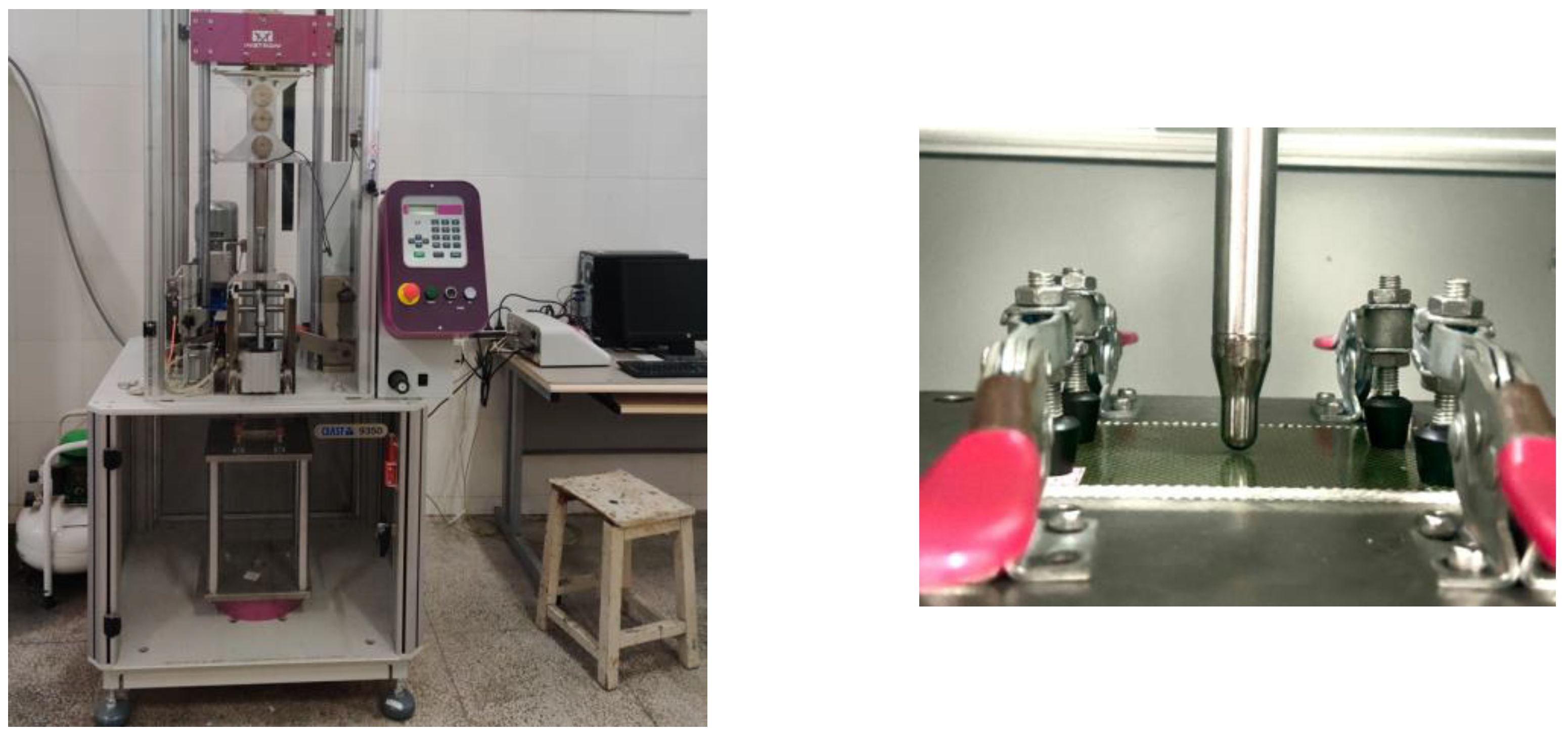

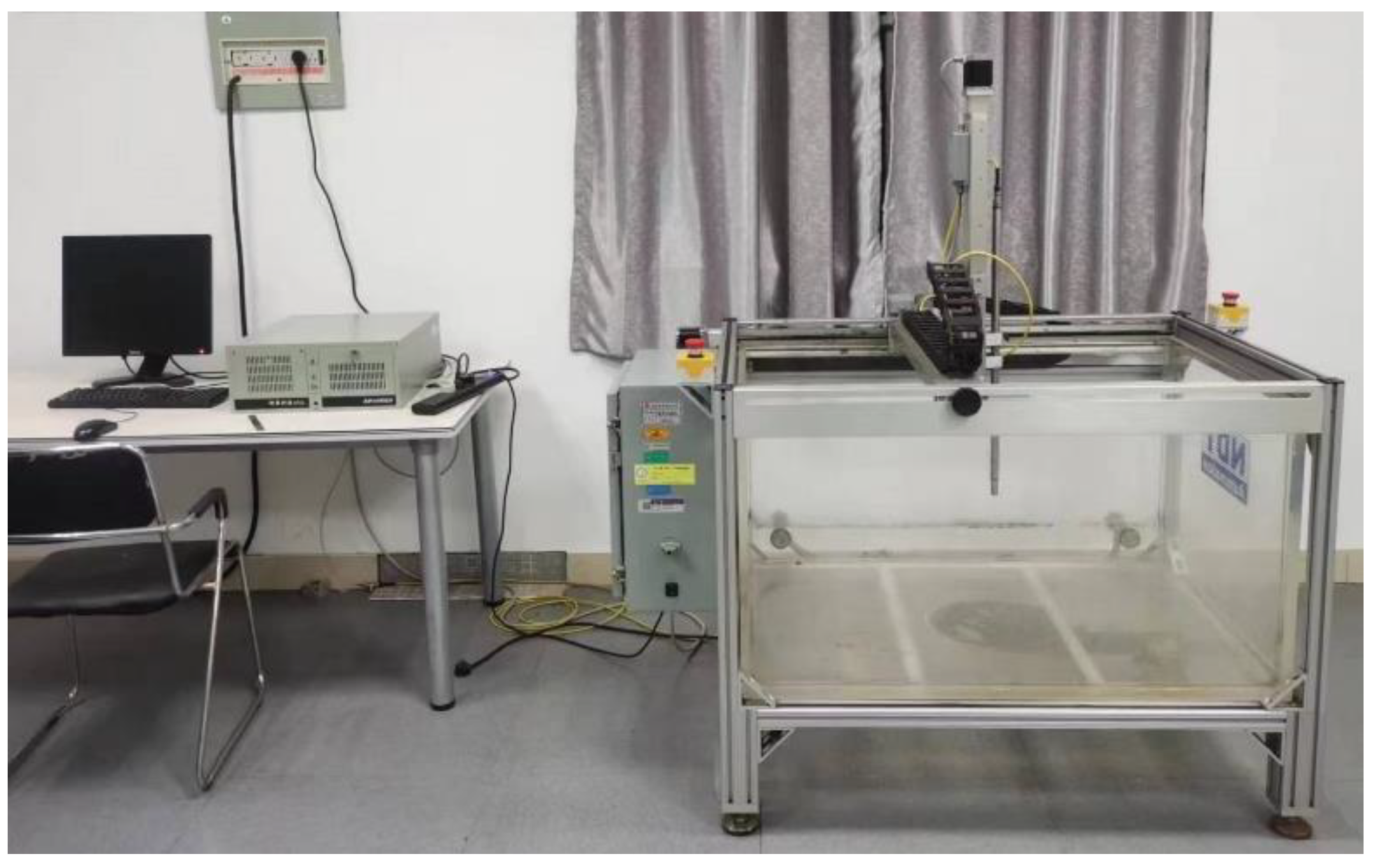
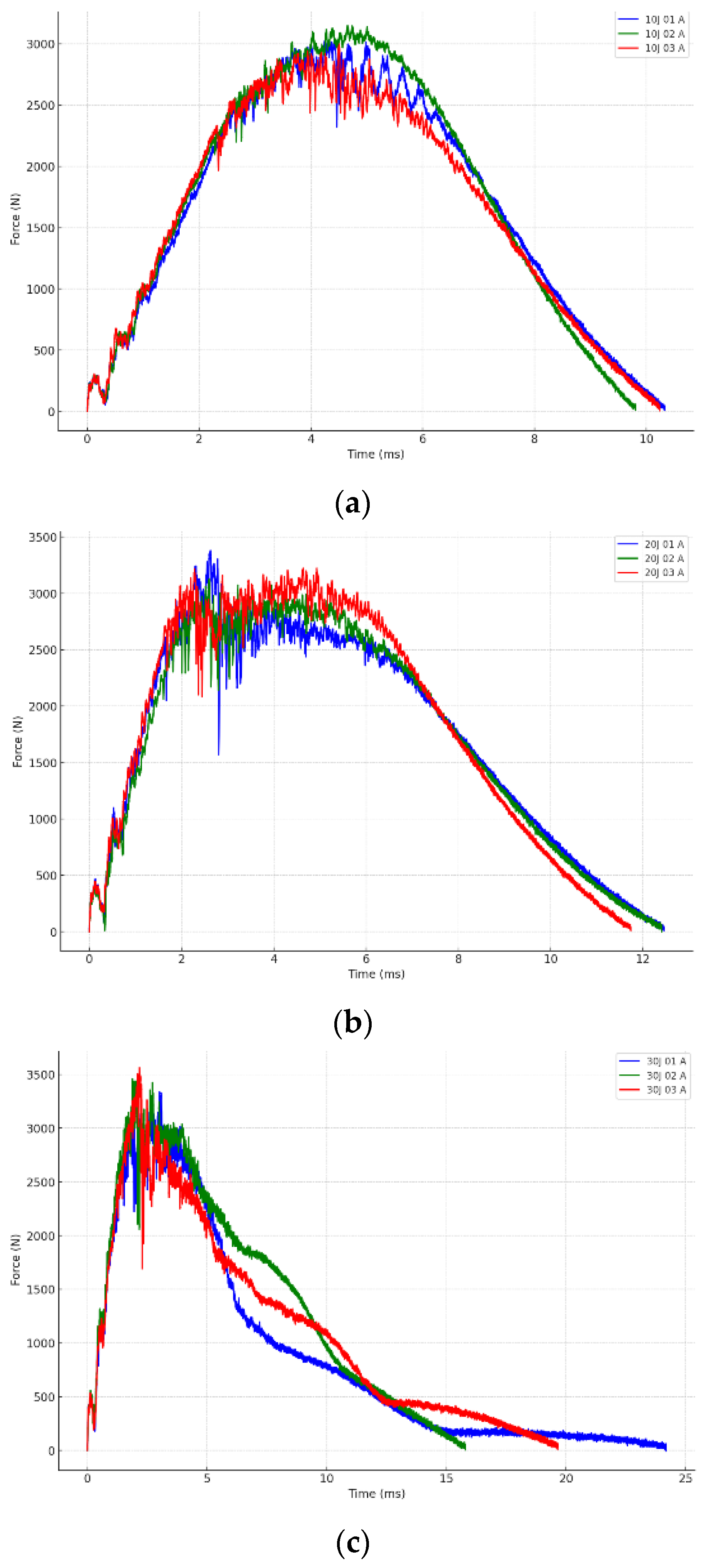
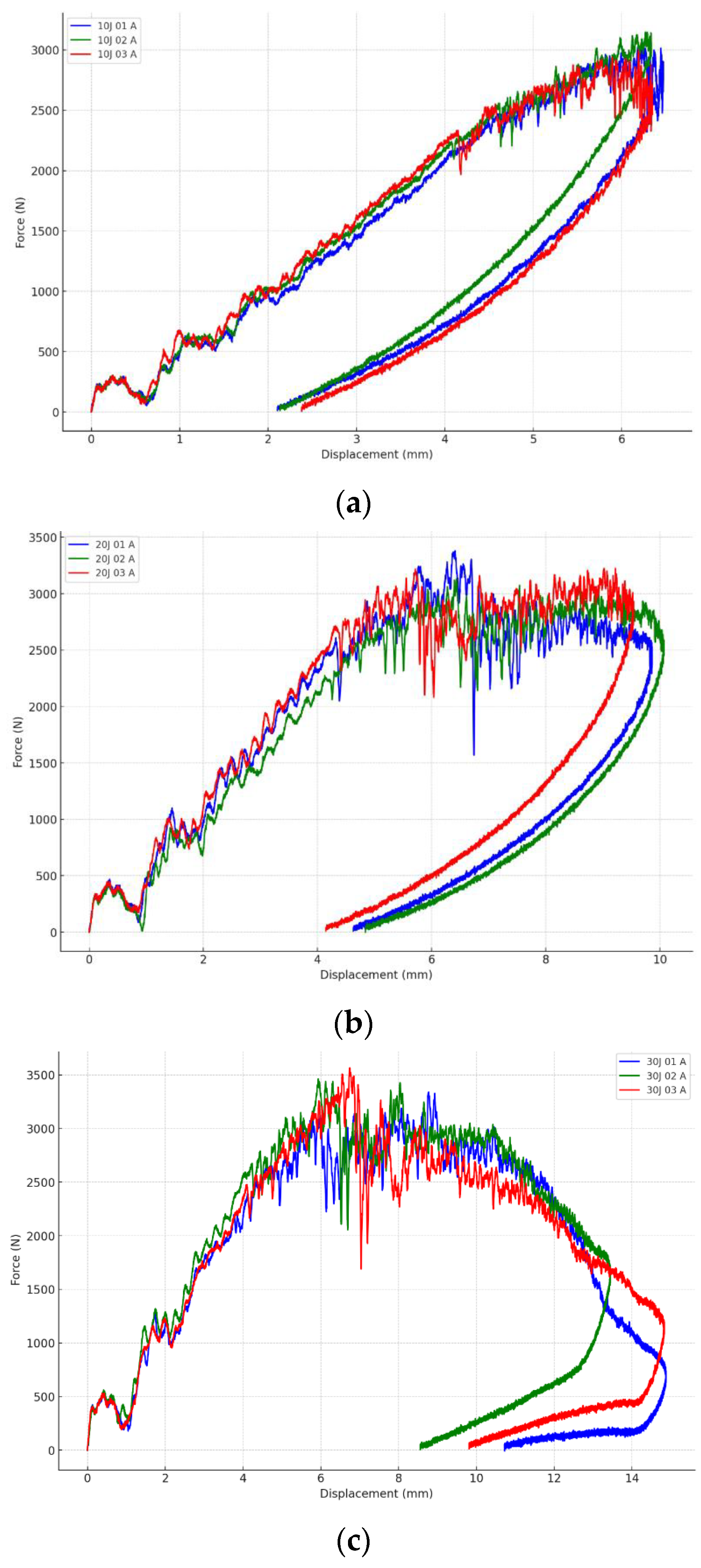

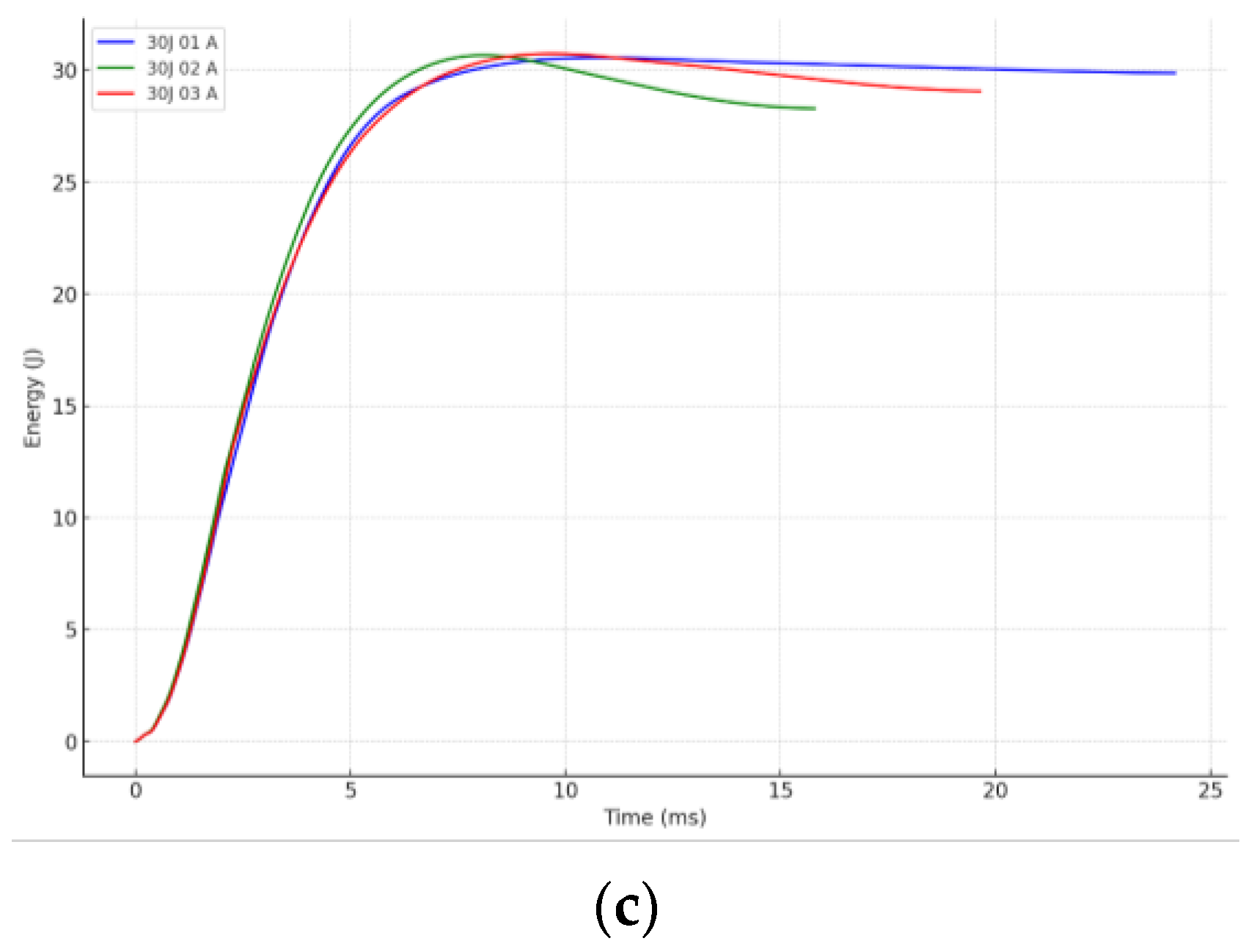
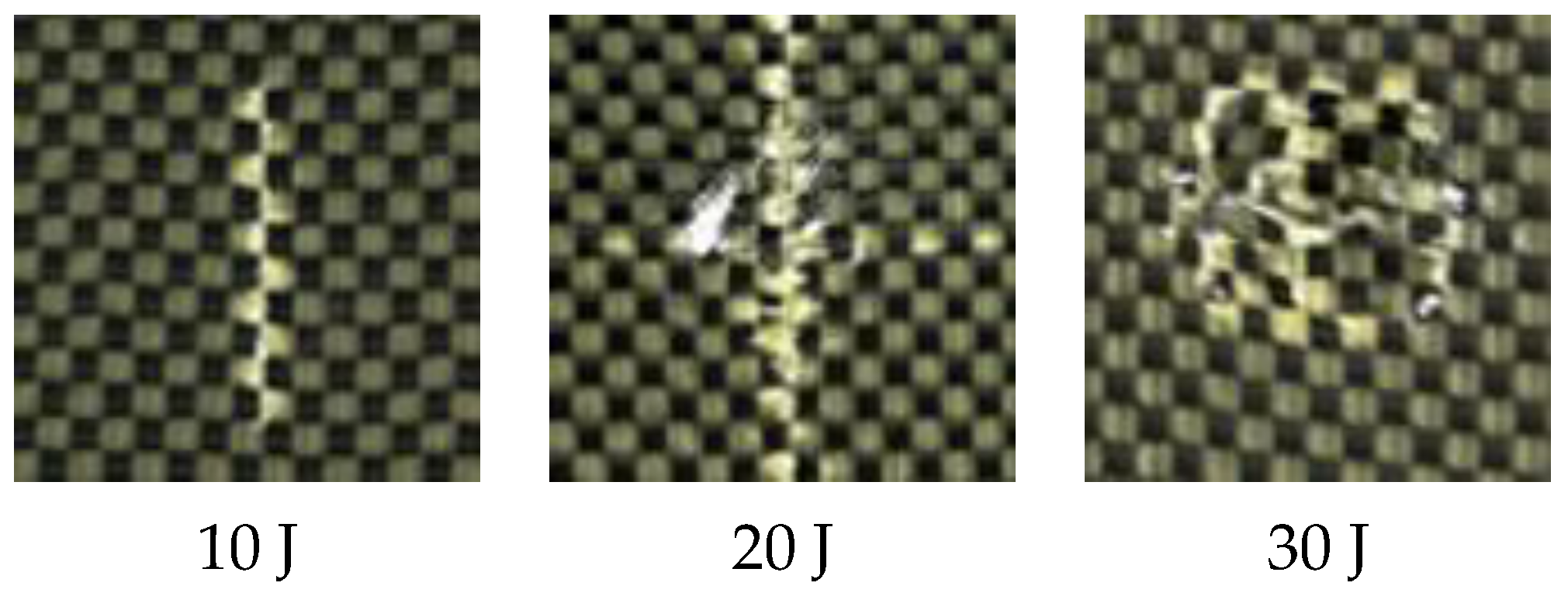
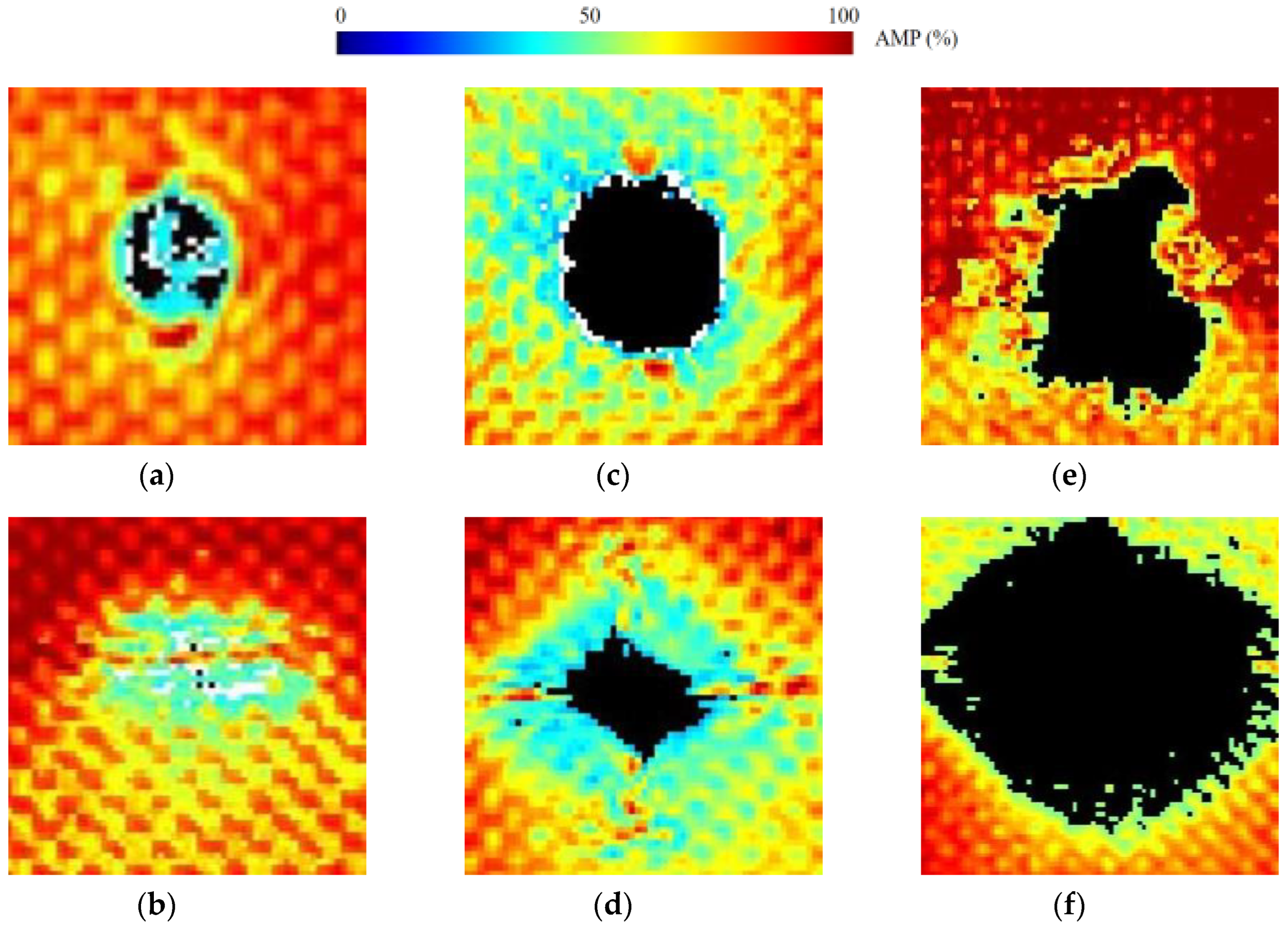
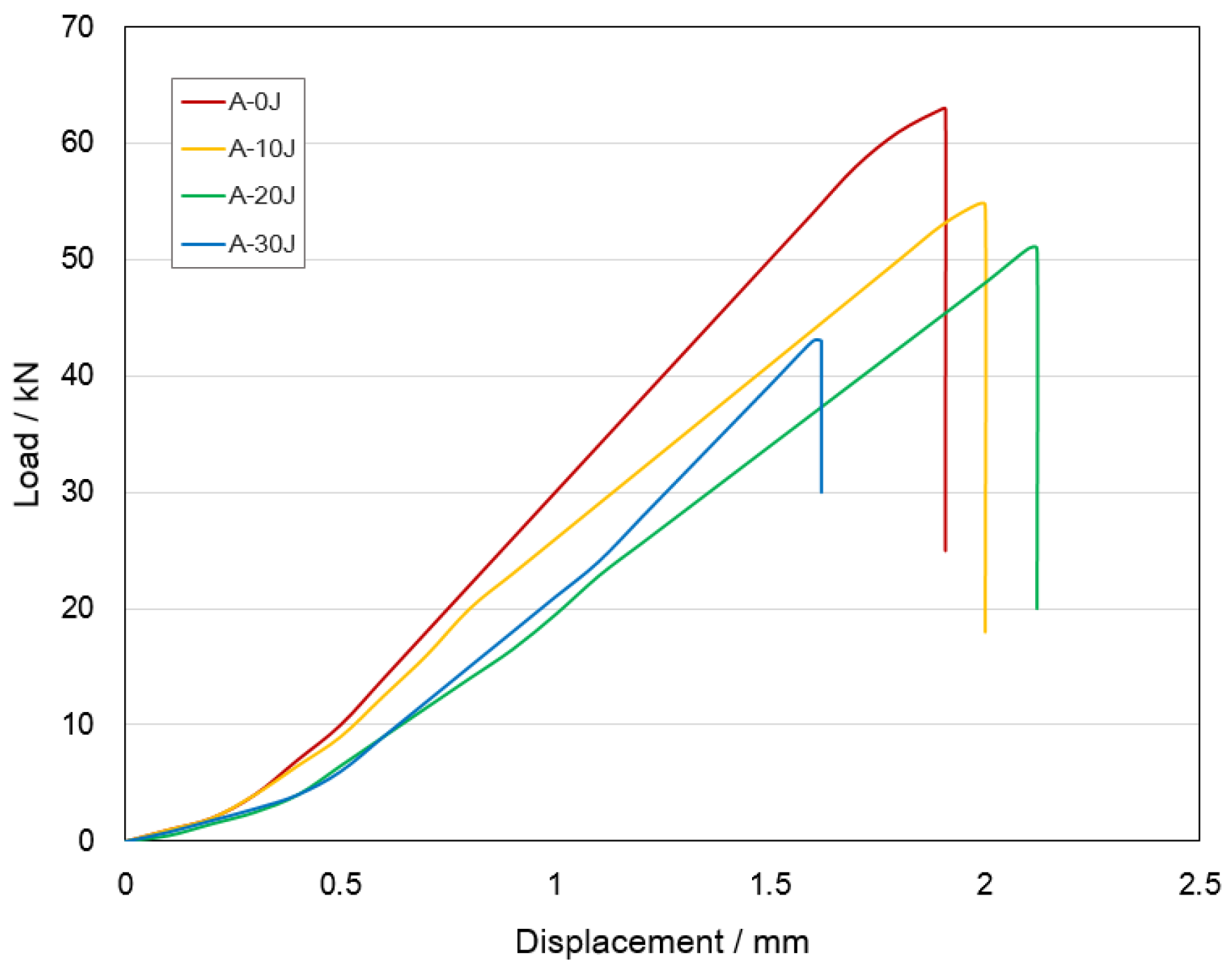
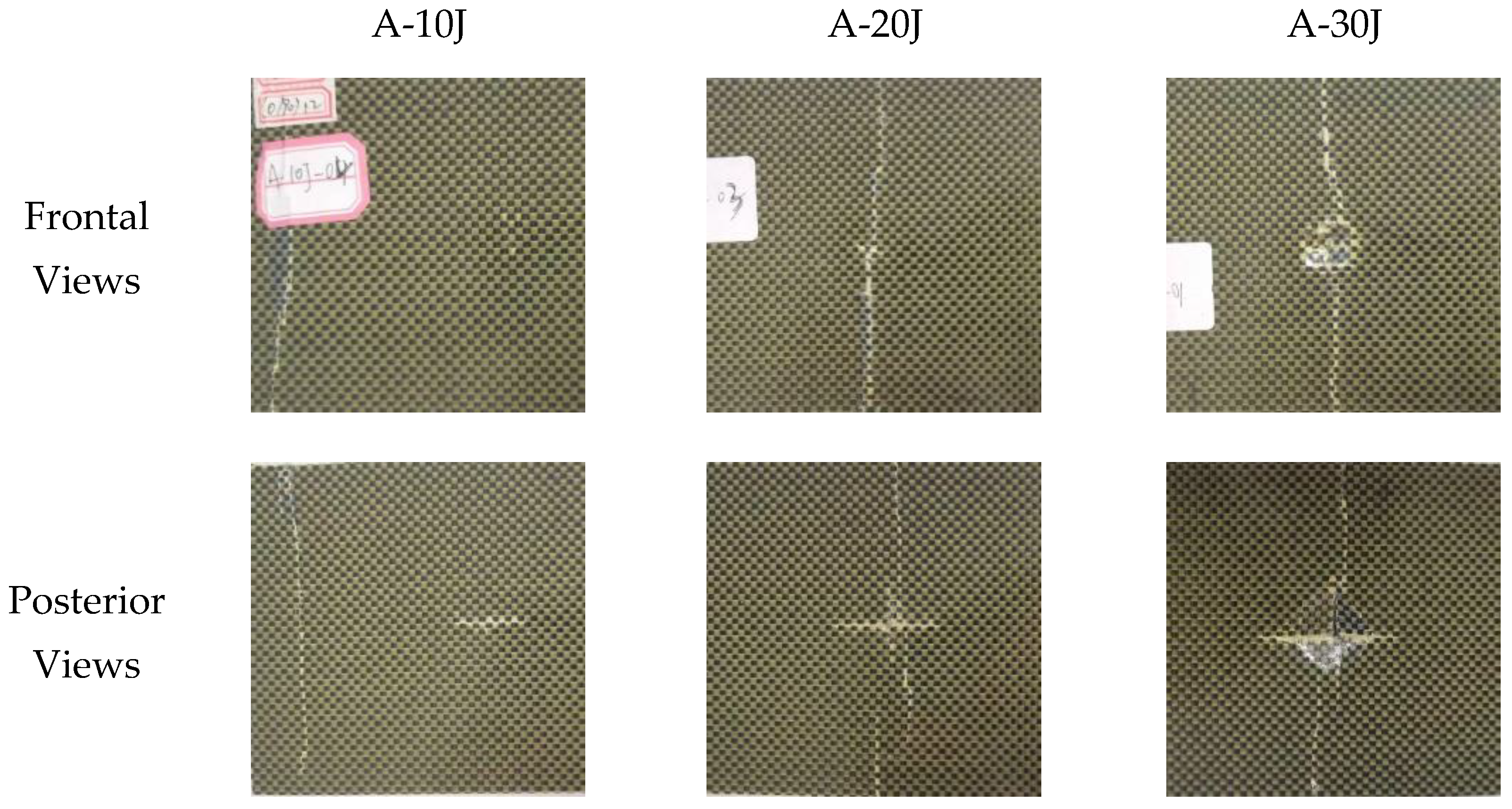
| Specimen | Force (kN) | Displacement (mm) | Residual Strength (%) |
|---|---|---|---|
| A-0J | 62.99 | 1.91 | 100.00% |
| A-10J | 54.72 | 1.98 | 86.87% |
| A-20J | 50.93 | 2.10 | 80.85% |
| A-30J | 43.01 | 1.62 | 68.28% |
Disclaimer/Publisher’s Note: The statements, opinions and data contained in all publications are solely those of the individual author(s) and contributor(s) and not of MDPI and/or the editor(s). MDPI and/or the editor(s) disclaim responsibility for any injury to people or property resulting from any ideas, methods, instructions or products referred to in the content. |
© 2024 by the authors. Licensee MDPI, Basel, Switzerland. This article is an open access article distributed under the terms and conditions of the Creative Commons Attribution (CC BY) license (https://creativecommons.org/licenses/by/4.0/).
Share and Cite
Li, Y.; Jin, Y.; Chang, X.; Shang, Y.; Cai, D. On Low-Velocity Impact Response and Compression after Impact of Hybrid Woven Composite Laminates. Coatings 2024, 14, 986. https://doi.org/10.3390/coatings14080986
Li Y, Jin Y, Chang X, Shang Y, Cai D. On Low-Velocity Impact Response and Compression after Impact of Hybrid Woven Composite Laminates. Coatings. 2024; 14(8):986. https://doi.org/10.3390/coatings14080986
Chicago/Turabian StyleLi, Yumin, Yongxing Jin, Xueting Chang, Yan Shang, and Deng’an Cai. 2024. "On Low-Velocity Impact Response and Compression after Impact of Hybrid Woven Composite Laminates" Coatings 14, no. 8: 986. https://doi.org/10.3390/coatings14080986
APA StyleLi, Y., Jin, Y., Chang, X., Shang, Y., & Cai, D. (2024). On Low-Velocity Impact Response and Compression after Impact of Hybrid Woven Composite Laminates. Coatings, 14(8), 986. https://doi.org/10.3390/coatings14080986






